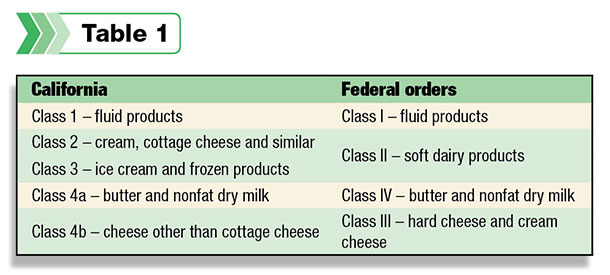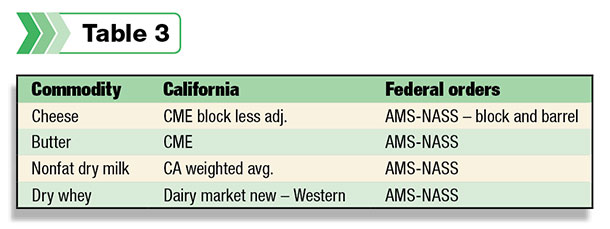Editor’s note: This is the last of four articles explaining producer payment systems for milk in the U.S. California produces a little more than 20 percent of U.S. milk and has its own unique payment system for paying producers for it. As mentioned in previous articles in this series, the three Federal Milk Marketing Order payment systems in the U.S. are very similar:
They base producer milk payments on the value of finished dairy products like cheese, butter, nonfat dry milk and dry whey. This article will compare the California system to the FMMO system.
Over time, as dairy markets went from local to national and now to international, volatility has increased. Today, weather and political factors halfway around the world in New Zealand, Australia or China can impact U.S. milk prices. This is true for all U.S. milk payment systems.
California’s payment system was established in 1935, after they were able to convince the courts that milk in California was intrastate commerce, not interstate commerce. Therefore, it was not subject to control by the federal government.
Because the California payment system has not had a major overhaul since its establishment, the formulas in the California system reflect the consumption characteristics of the 1930s. Butterfat was the only component with extraordinary value at that time. Today, protein is typically more valuable than butterfat, but payment specifically for protein does not exist in the California system.
While there are mathematical differences between the California and the Federal Milk Market Order calculations for payment, they are both based on many of the same principles. All U.S. systems begin with the free-market valuation of processed milk products, like cheese and butter, and then are calculated “upstream” to create a free-market price for producer milk.
The California milk pricing system is different from the federal order system in at least eight ways. In the explanations below, “solids not fat” are all solids including protein, lactose and other trace items like vitamins and minerals. “Other solids” in the FMMO system are the same – except that protein is not included.
It is valued separately. In the standardized FMMO formulas, “other solids” account for 5.7 percent of the milk, and protein accounts for 3 percent of the milk. Similarly, “solids not fat” amount to 8.7 percent of the milk in standardized California formulas.
1. California has five classes of milk, and the federal orders have four.
2. Producers are paid based on pounds of butterfat and pounds of “solids not fat,” compared to the FMMOs that pay on hundredweight (cwt) of skim and pounds of butterfat in the advanced system, and pounds of butterfat, true protein and “other solids” in the FMMO component system.
3. California has a quota system, whereas the federal order system has no quotas.
4. California has different pricing for north and south California, while the federal orders do not have different prices geographically.
5. California has a cap on the top prices for dry whey which primarily lowers the value of the “other solids” portion of “solids not fat” when the market value of dry whey is high. There is also a bottom cap which prevents dry whey from going negative, which rarely happens.
6. California recognizes butter that comes from whey is worth less than butter churned directly from butterfat.
7. California depends on public information like the Chicago Mercantile Exchange (CME) for wholesale prices of cheese and butter, whereas the federal orders have their own organization (AMS-NASS) for determining the value of dairy commodities.
8. California reduces the price of cheese from the CME value, recognizing that wholesale prices for California cheese are lower than prices in the Midwest.
9. Make allowances are less in California than in the federal orders.
Of the above factors, the most significant would probably be the limits on the value of dry whey. When dry whey is high-priced, “other solids” can be worth more than $2.50 per cwt of milk, but in the California system, they are limited to $0.75 per cwt.
Prior to 2009, “other solids” portion of “solids not fat” was limited to $0.25 per cwt in the California system. (During the one-year period from Aug. 1, 2015 to July 31, 2016, California allows for payment of up to $2 per cwt for “other solids.”)
This limitation in payment for “other solids” has put California dairymen at a disadvantage of nearly $2 per cwt in some years. That one item has created considerable unrest with California dairymen.
A simplification of the classes would roughly align the California and federal order classes as shown in Table 1.

Most dairy equations follow a standard format. For example:
Butterfat price = (butter price – make allowance) x (yield factor)
In the above equation, the make allowance represents the manufacturing cost for churning butter from butterfat.
Make allowances are generally lower in the California system than in the federal order system, as shown in Table 2.

Lower make allowances make producer milk prices higher.
The rational conclusion for this would be that California dairy processors are more efficient and, therefore, have lower costs. Of course, there is always negotiation involved in setting make allowances.
California producers and their organizations have begun exploring a possible change from their current payment system to becoming a separate federal order. The lower pay for “other solids” is a prime factor. Some of the items complicating the process are the existing quota system and the North versus South payment differential.

Many producers have paid a lot of money to buy quota. The quota allows them to receive a higher price for milk covered by the quota. The quota system was originally developed to satisfy producers that had higher-paid Class 1 contracts as they moved to a more “uniform” payment system.
It evolved into something very different where quota is openly bought and sold with the expectation of a higher price for the milk covered by the quota. That increase can be as much as $1.70 per cwt. A conversion to the federal order system will have to deal with this issue.
Behind every milk value equation, there is an underlying commodity evaluation. California depends on public data for evaluations of these commodities. The federal order system uses the survey conducted by AMS-NASS.
CME and NASS prices are very consistent, so there is very little difference between the milk payment systems based on their choice of sourcing pricing data.
It’s often stated that the California system’s shortcoming is that they do not pay specifically for protein. In a state where cheese and nonfat dry milk are huge, protein is very important. Through their formulas, California does pay a decent price for protein, but it is combined and diluted with the low value of dry whey, removing financial incentives for increasing milk protein.
Some California cheese processors do pay a premium for high protein levels to create an effective incentive for protein development.
When California developed their milk payment system, California milk was truly intrastate. Today, that is clearly not the case. Is there really a need for a separate milk payment system today? If California prices could be made comparable to federal order prices, why would a separate system have to be maintained? America has developed cost efficiencies by simplification and standardization. Should it happen here?
The largest growth area for the U.S. dairy industry is exports. California is in an excellent geographical position to take advantage of this market. Total efficiency is needed to compete in the global dairy markets.
Does a separate system of payment, with the overhead of maintaining the system, benefit the U.S. dairy industry? Would payment for protein change producers’ incentives to increase protein levels needed for the growth categories? PD
Click here to read the first article "Producer milk payment systems in the U.S.
Click here to read the second article "How the FMMO's component payment system works"
Click here to read the third article "The Federal Milk Market Order's advanced payment system"

-
John Geuss
- John Geuss Consulting
- Email John Geuss




